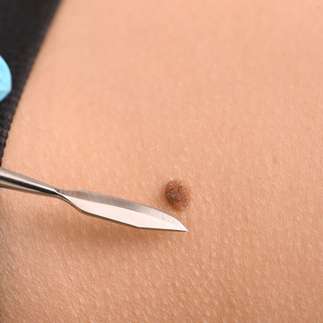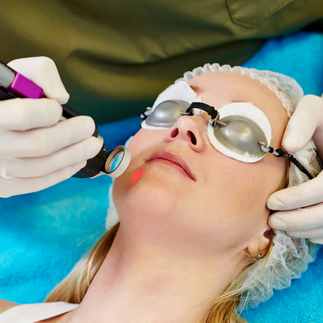Is it possible to remove a mole by oneself at home?
- fundamentalmedical
- Jan 19, 2024
- 4 min read
Updated: Jun 4
Are moles harmful?
Skin moles, also known as beauty marks or nevi, are common skin growths that can appear anywhere on the body. In most cases, moles are harmless and do not pose any health risks.

Skin moles can vary in terms of their characteristics and potential risks. While most moles are harmless and considered beauty marks, it's important to keep an eye on your moles and be aware of any changes in their size, shape, color, or texture that could be cancerous.
What Is A Cancerous Mole?
A cancerous mole, also known as melanoma (cancerous cells), is a mole that exhibits certain warning signs. These signs include asymmetry (when one half of the same mole's shape doesn't match the other), irregular borders (may have blurred or jagged edges), varied colors within the mole (display multiple colors, such as shades of brown, black, red, blue, or white), a large diameter (typically larger than 6 mm, about a pencil eraser), and evolving size, shape or color. If you notice any suspicious changes in your moles, it's crucial to consult with a dermatologist for proper evaluation and diagnosis. They have the expertise to determine whether further investigation or treatment is required.
Can I remove a mole myself?
As for at-home mole removal, it is generally not recommended. Attempting to remove a mole at home can lead to complications. It's always best to seek professional medical advice from a dermatologist who can perform safe and effective removal procedures if necessary.
Remember, when it comes to your skin health, seeking guidance from qualified professionals ensures your safety and well-being.
What are the risks/adverse effects involved when removing moles at home?
Removing moles at home can pose significant risks and potential dangers. It is crucial to understand the possible complications that may arise from DIY mole removal.
Self-mole removal techniques can lead to bleeding, chances of regrowth, infection, and permanent scar. DIY methods can lead to misdiagnosis as moles can sometimes be precancerous or cancerous lesions requiring medical attention.
Various devices claim to let you remove moles, skin tags and other lesions at home — here's why you should think twice before tackling this procedure without a doctor
(The DIY don'ts)
Cutting or Shaving Moles at Home: A Risky Approach
One major concern is the risk of bleeding. Moles often have blood vessels running through them, and cutting or shaving them off without proper medical training can lead to excessive bleeding that may be difficult to control.
Another significant risk is scarring. However, attempting this at home without proper knowledge and tools can result in noticeable scars that may take longer to heal or even become permanent.
Furthermore, there is a risk of infection when performing any type of surgical procedure at home without sterile conditions. Infections can be painful and potentially require medical intervention.
Lastly, even if you manage to remove a mole successfully at home, there is no guarantee that it won't regrow or reappear later on. Professional methods involve the complete removal of the mole cells from beneath the skin surface, which greatly reduces the chance of regrowth.
Using Chemical Solutions: Potential Harmful Effects
While these products may seem appealing due to their convenience, it's important to consider the potential risks involved.
One common concern is the risk of chemical burns when using acid solutions. These solutions contain powerful ingredients that can be harsh on the skin if not used correctly or if left on for too long. It is crucial to follow the instructions provided by the manufacturer carefully and perform a patch test before applying it to larger areas.
Additionally, scarring or pigmentation changes can occur after mole removal procedures. This is because removing a mole involves breaking or damaging the skin in some way, which can lead to scar formation or changes in pigmentation.
Natural/Home Remedies and Homeopathic Treatments: Do They Work?
Natural remedies and homeopathic treatments have been a topic of interest for many individuals seeking alternative solutions. While some people believe in their effectiveness, it is important to approach these treatments with caution and consider the scientific evidence available.
When it comes to natural mole removal methods, one popular option is apple cider vinegar. Advocates claim that applying apple cider vinegar directly to moles can cause them to shrink or disappear over time. However, it's essential to note that there is limited scientific research supporting this claim. The anecdotal evidence from individuals who have tried this method varies, with some reporting positive results while others see no improvement.
Another option often mentioned is mole removal cream. These creams typically contain ingredients such as bloodroot or zinc chloride that are believed to dissolve the unwanted moles gradually. Again, the effectiveness of these creams may vary from person to person, and more research is needed before making any definitive claims.
Baking soda is another household ingredient often suggested as a natural remedy for moles. Some people mix baking soda with water or other substances to create a paste which they then apply topically on moles. Unfortunately, there is no solid scientific evidence indicating that baking soda can safely and effectively remove moles.
As for homeopathic remedies for moles, they rely on the principle of "like cures like," where highly diluted substances are used in an attempt to stimulate the body's healing response. However, it's important to note that homeopathy lacks substantial scientific evidence backing its efficacy beyond a placebo effect.
Remember that everyone's body responds differently, so what may work for one person might not work for another when it comes to natural remedies and homeopathic treatments.
What is the best way to go about it if so - Safe and Effective Mole Removal Techniques
To ensure safe mole removal, it is advisable to consult with a dermatologist, medical professional, or other qualified healthcare provider who specializes in skin conditions.
They possess both expertise and appropriate equipment for assessing moles accurately and removing them safely. Professional methods of removing moles include surgical excision, cryotherapy (freezing), laser treatment (topical numbing cream will be applied first), or shave excision under local anesthesia.
These techniques are performed by experienced professionals who prioritize your safety while achieving optimal results. Remember that when it comes to your health and well-being, it is always best to seek expert advice rather than attempting risky DIY surgical procedures yourself.
Mole Removal Singapore
Read more:













Comments